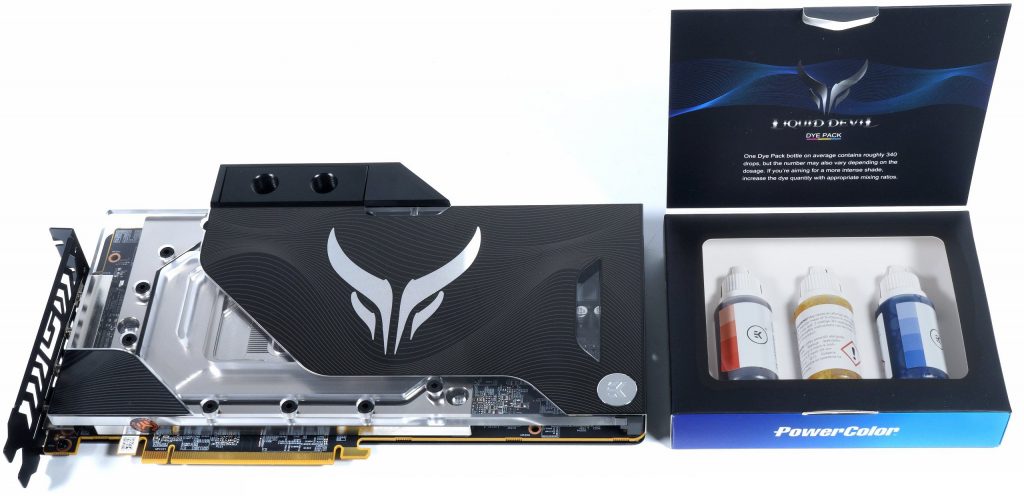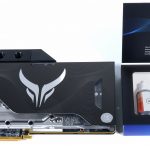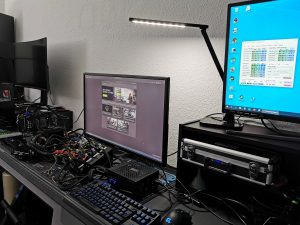In the meantime, in addition to the already extensively tested reference cards of AMD’s RX-6000 series, there are also various board partner cards – not for sale – which include the truly exceptional PowerColor RX 6900XT Liquid Devil. After some back and forth due to the postponement of the release date, the time has finally come and I can finally present you this top model in real. By the way, the special thing about it is the special thing on it, which is a real full-cover waterblock for cooling and not a simple AiO watercooler or even an aircooler. Water must run here and not too scarce! Let’s see what we can do…
With the (Attention! Officially mandated name) “PowerColor Liquid Devil AMD Radeon™ RX 6900 XT Gaming Graphics Card with 16GB GDDR6, AMD RDNA™ 2”, which for the sake of simplicity I will again call “PowerColor RX 6900 XT Liquid Devil” in the article, as otherwise the charts and legends would explode, here is a particularly fast, well cooled, and thus slightly thirstier RDNA2 specimen on my table of good deeds, just waiting to be put under water for once.
In addition to the card and the two required plugs for the terminal, three colorful bottles with paint for the coolant are included. And from the packaging of this extra and the logo on the cooler, you can see that it was made by EKWB. However, the card is assembled at TUL, i.e. PowerColor. But more on that later.
This graphics card, like all RX6000 cards, can handle the new video codec AV1, it also supports DirectX 12 Ultimate for the first time and thus also DirectX Raytracing (DXR). With AMD FidelityFX, it also offers a feature that should also give developers more leeway in choosing effects. Also included is Variable Rate Shading (VRS), which can save immense amounts of processing power by smartly reducing the display quality of areas of the image that are not in the player’s eye anyway. So much for the feature set of all new Radeon cards.
Optics and haptics
The PowerColor Radeon RX 6900 XT Liquid Devil weighs a whopping 1654 grams dry and without any other connections on the terminal, but including the plugs, and is thus not exactly a lightweight! It is with its approx. 27 cm rather medium-long, but proud 16 cm high (13.5 cm installation height from PEG) and due to the bezel 3.8 cm thick (2-slot design), whereby a backplate and the PCB with a total of four additional millimeters are added. The radiator is made of nickel-plated copper with an aluminum overlay including logo. The terminal is solid and made of acetal. The colorful power extends as a light bar with internal aRGB connection on the PCB.
The slot bracket is nicely decorated, carries 1x HDMI 2.1 and two DP ports instead of three. However, the USB Type C jack is available as an alternative. More about the construction, the cooler and the assembly on the next page in the teardown.
Technology and Dual BIOS
With the 80 compute units (CU), the RX 6900 XT has 5120 shaders. While the base clock of the Primary BIOS (BIOS 1 Normal) is specified with 2135 MHz and the Boost clock with 2365 MHz, the Secondary BIOS must get along with 1499 MHz base clock (why actually?) and may sprint in return in the Boost up to 2499 MHz, which is also often enough reached and even exceeded. The card uses 16 GB of GDDR6 at 16 Gbps, which is made up of 8 modules of 2 GB each. This includes the 256-bit memory interface and the 128MB Infinity Cache, which is supposed to solve the bandwidth problem, but struggles a bit with the hit rate starting with Ultra-GD.
The two screenshots from GPU-Z first give information about the key data of the two BIOSes – on the left you see the normal BIOS (1), on the right the OC BIOS (2):
But where are the other, much more important differences between the two BIOS variants? We can see the details by reading the BIOS. Let’s especially take a look at the “Thermal Graphics Power”, because 289 watts and 301 watts meet here.
Raytracing / DXR
At the latest since the presentation of the new Radeon cards it is clear that AMD will also support ray tracing. Here one goes a way clearly deviating to NVIDIA and implements a so-called “Ray Accelerator” per Compute Unit (CU). Since the Radeon RX 6800 has a total of 72 CUs, this also results in 72 such accelerators for the Radeon RX 6800XT, while the smaller Radeon RX 6800 still has 60. A GeForce RTX 3080 comes with 68 RT cores, which is nominally less for now. When comparing the smaller cards, the score is 62 for the RX 6800 and 46 for the GeForce RTX 3070. However, RT cores are organized differently and we will have to wait and see what quantity can do against specialization here. So in the end it’s an apples and oranges comparison for now.
But what has AMD come up with here? Each of these accelerators is first capable of simultaneously computing up to 4 beam/box intersections or a single beam/triangle intersection per cycle. This way, the intersection points of the rays with the scene geometry are calculated (analogous to the Bounding Volume Hierarchy), first pre-sorted and then this information is returned to the shaders for further processing within the scene or the final shading result is output. NVIDIA’s RT cores, however, seem to have a much more complex approach to this, as I explained in detail during the Turing launch. What counts is the result alone, and that’s exactly what we have suitable benchmarks for.
Smart Access Memory (SAM)
AMD already showed SAM, i.e. Smart Access Memory, at the presentation of the new Radeon cards – a feature I enabled today in addition to the normal benchmarks, which also allows a direct comparison. But actually SAM is not Neuers, just verbally more nicely packaged. This is nothing else than the clever handling of the Base Address Register (BAR) and exactly this support must be activated in the substructure. With modern AMD graphics hardware, resizable PCI bars (see also PCI SIG from 4/24/2008) have played an important role for quite some time, since the actual PCI BARs are normally only limited to 256 MB, while with the new Radeon graphics cards you can now find up to 16 GB VRAM.
The result is that only a fraction of the VRAM is directly accessible to the CPU, which without SAM requires a whole series of workarounds in the so-called driver stack. Of course, this always costs performance and should therefore be avoided. So that’s where AMD comes in with SAM. This is not new, but it must be implemented cleanly in the UEFI and later also activated. This only works if the system is running in UEFI mode and CSM/Legacy are disabled.
CSM stands for the Compatibility Support Module. The Compatibility Support Module is exclusive to UEFI and ensures that older hardware and software will work with UEFI. The CSM is always helpful when not all hardware components are compatible with UEFI. Some older operating systems and the 32-bit versions of Windows also do not install on UEFI hardware. However, it is precisely this compatibility setting that often prevents the clean Windows variant required for the new AMD components from being installed.
Benchmarks and evaluation
For the benchmarks, I chose the same 10 games, analogous to the launch article, weighting between old and new, and AMD- or NVIDIA-specific. Since everything is very similar to the launch article of the Radeon cards, this time there is only a cumulative summary of all games with a detailed explanation for each resolution. The power consumption is also given in great detail, as you are used to.
Test system and evaluation software
The benchmark system is new and now completely relies on AMD. PCIe 4.0 is of course mandatory. This includes the matching X570 motherboard in the form of an MSI MEG X570 Godlike and the Ryzen 9 5950X, which is water-cooled and slightly overclocked. Add to that the matching DDR4 4000 RAM from Corsair in the form of the Vengeance RGB, as well as several fast NVMe SSDs. For direct logging during all games and applications, I use both NVIDIA’s PCAT and my own shunt measurement system, which adds to the convenience immensely. The measurement of the detailed power consumption and other somewhat more complicated things is carried out in the special laboratory on two tracks by means of high-resolution oscillograph technology…
…and the self-created MCU-based measurement setup for motherboards graphics cards (pictures below), where at the end in the air-conditioned room also the thermographic infrared images are created with a high-resolution industrial camera. The audio measurements are then done outside in my Chamber (room-within-a-room).
The software used relies on my own interpreter including evaluation software as well as a very extensive and flexible Excel sheet for the graphical implementation. I have also summarized the individual components of the test system in a table:
| Test System and Equipment |
|
|---|---|
| Hardware: |
AMD Ryzen 9 5950X OC MSI MEG X570 Godlike 2x 16 GB Corsair DDR4 4000 Vengeance RGB Pro 1x 2 TByte Aorus (NVMe System SSD, PCIe Gen. 4) 1x 2 TB Corsair MP400 (Data) 1x Seagate FastSSD Portable USB-C Be Quiet! Dark Power Pro 12 1200 Watt |
| Cooling: |
Alphacool Ice Block XPX Pr o Alphacool Ice Wolf (modified ) Thermal Grizzly Kryonaut |
| Case: |
Raijintek Paean |
| Monitor: | BenQ PD3220U |
| Power Consumption: |
Oscilloscope-based system: Non-contact direct current measurement on PCIe slot (riser card) Non-contact direct current measurement at the external PCIe power supply Di rect voltage measurement at the respective connectors and at the power supply unit 2x Rohde & Schwarz HMO 3054, 500 MHz multichannel oscilloscope with memory function 4 x Rohde & Schwarz HZO50, current clamp adapter (1 mA to 30 A, 100 KHz, DC ) 4x Rohde & Schwarz HZ355, probe (10:1, 500 MHz) 1x Rohde & Schwarz HMC 8012, HiRes digital multimeter with memory fu n ction MCU-based shunt measuring (own build, Powenetics softw are) Up to 10 channels (max. 100 values per seco nd) Special riser card with shunts for the PCIe x16 slot (PE G ) NVIDIA PCAT and FrameView 1.1 |
| Thermal Imager: |
1x Optris PI640 + 2x Xi400 Thermal Imagers Pix Connect Software Type K Class 1 thermal sensors (up to 4 channels) |
| Acoustics: |
NTI Audio M2211 (with calibration file) Steinberg UR12 (with phantom power for the microphones) Creative X7, Smaart v.7 Own anechoic chamber, 3.5 x 1.8 x 2.2 m (LxDxH) Axial measurements, perpendicular to the centre of the sound source(s), measuring distance 50 cm Noise emission in dBA (slow) as RTA measurement Frequency spectrum as graphic |
| OS: | Windows 10 Pro (all updates, current certified or press drivers) |
- 1 - Introduction and technical details
- 2 - Teardown: PCB, power supply and cooler
- 3 - Gaming performance
- 4 - Gaming power draw in detail and efficiency
- 5 - Power consumption, voltages and standards
- 6 - Transients and PSU recommendation
- 7 - Clock rate and temperatures, infrared
- 8 - Overview and conclusion




























































87 Antworten
Kommentar
Lade neue Kommentare
Urgestein
1
Urgestein
Veteran
Urgestein
Mitglied
Mitglied
Veteran
Neuling
Mitglied
Urgestein
Mitglied
Urgestein
Mitglied
Urgestein
Mitglied
Urgestein
Mitglied
1
Alle Kommentare lesen unter igor´sLAB Community →